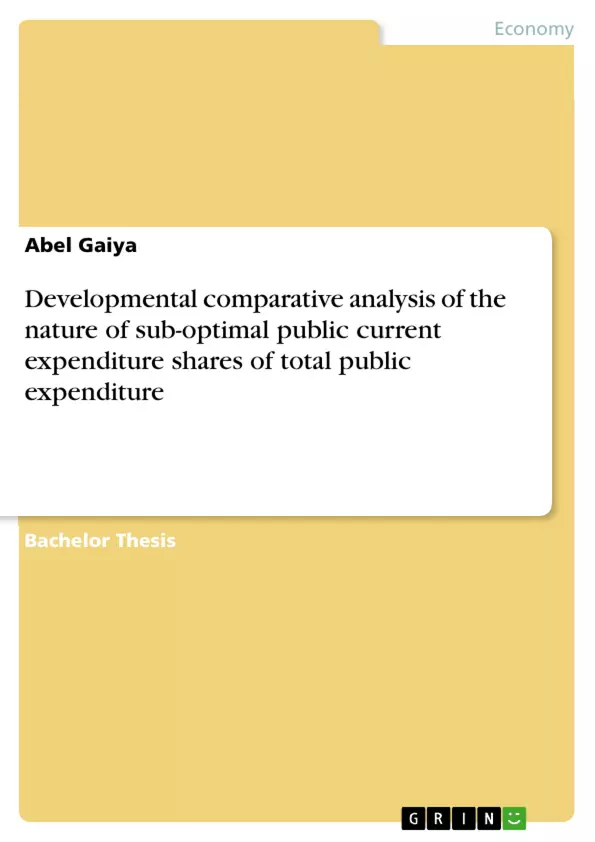An investigation into the patterns of general government current expenditure shares of total expenditure, as well as patterns of optimality and sub-optimality, between developed and developed countries, has been undertaken. Discussion over this metric has largely been limited to publicized comments, the informal blogosphere and news commentary; this paper presents a contribution towards the subject. Using econometric methods and statistical analysis, a wide range of results are uncovered regarding the cross-developmental patterns of current shares, their optimum values and sub-optimality.
The first is that developed countries generally have higher current shares as a proportion of total government expenditure, than developing countries; but the variation of these shares across developing countries is significantly greater, although it is trending downwards over time. Secondly, although prima facie evidence shows that the optimum current shares for developed countries are greater than for developing countries, statistical robustness is elusive – most likely due to statistical and data limitations within the research. Thirdly, there is little evidence that the general deviation of current shares from optimum – that is, sub-optimum behaviour – significantly differs between developed and developing countries. Lastly, observed sub-optimum behaviour of current shares does not seem to be driven by government ineffectiveness.
Inhaltsverzeichnis (Table of Contents)
- INTRODUCTION
- LITERATURE REVIEW
- METHODOLOGY
- EMPIRICAL RESULTS
- DISCUSSION
- CONCLUSION
Zielsetzung und Themenschwerpunkte (Objectives and Key Themes)
This research paper aims to conduct a comparative analysis of the patterns of current expenditure shares of total public expenditure between developed and developing countries. It aims to determine the optimum values and sub-optimality of these shares across different developmental stages. By using econometric methods and statistical analysis, the study aims to contribute towards a deeper understanding of the subject, which has been previously limited to informal commentary and news reports.
- Developmental patterns of current expenditure shares
- Optimum values of current expenditure shares
- Sub-optimality of current expenditure shares
- Comparative analysis between developed and developing countries
- Impact of public current expenditures on economic growth
Zusammenfassung der Kapitel (Chapter Summaries)
- INTRODUCTION: This chapter introduces the research topic by highlighting the concerns regarding the high level of public recurrent expenditure in developing countries. It states the objective of the study, which is to conduct a comparative analysis of current expenditure shares between developed and developing countries and assess their optimality. It mentions the limitations of previous research and the need for a more comprehensive and technical analysis.
- LITERATURE REVIEW: This chapter reviews relevant theoretical and empirical literature related to government expenditure. It discusses Wagner's Law of increasing state activity, which predicts that government expenditure increases as an economy grows. The chapter also examines the Ratchet Hypothesis, which suggests that government expenditure tends to increase over time, even during periods of economic decline.
- METHODOLOGY: This chapter outlines the methodology adopted for the empirical analysis. It describes the approach to compare current expenditure shares of total general government expenditure between developed and developing countries, aiming to understand the developmental significance of these shares, their optimality, and patterns of sub-optimality.
Schlüsselwörter (Keywords)
This research paper explores the field of public economics and focuses on government expenditures and related policies. The key concepts include public current expenditure shares, developmental patterns, optimality, sub-optimality, comparative analysis, economic growth, Wagner's Law, and the Ratchet Hypothesis. The study analyzes the empirical relationship between public current expenditures and economic development, aiming to provide insights into the role of government spending in promoting economic growth and achieving sustainable development.
- Citar trabajo
- Abel Gaiya (Autor), 2016, Developmental comparative analysis of the nature of sub-optimal public current expenditure shares of total public expenditure, Múnich, GRIN Verlag, https://www.grin.com/document/353593



